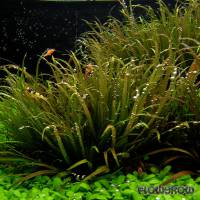



Blyxa japonica grows exclusively submersed, in shallow ponds, in swamps and slow-flowing woodland rivers rich in iron, in subtropic and tropical regions of East and South-East Asia. Throughout its area of distribution, it can also be found in rice paddies. This Blyxa species has become a very familiar plant in the aquarium hobby due to its attractive, grasslike, bushy habit.
Its cultivation is not especially difficult, if some basic requirements are met: sufficient light (0.5-1 watt per litre or more), CO2 supply and fertilisation with nitrate, phosphate, potassium and micronutrients. When cultivated in optimal conditions and under sufficient light, the plant displays golden and reddish hues and a more compact growth habit. Under insufficient light, B. japonica grows higher and greener, with a more lanky habit. The plant develops a very large root system and likes its substrate rich in nutrients, or bottom fertilisers, respecitvely. When phosphate levels are high (1-2 mg per litre), it regularly shoots long stems with tiny white flowers.
Even though it may look rather like a rosulate plant, in reality B. japonica is a stem plant with a very short stem with extremely dense leaves. It is not as invasive as other grasslike fore- and middleground plants as it does not form long runners. Instead, it grows lateral shoots at the basis, which can easily be cut with a pair of scissors and then be replanted. It might be a tad difficult to anchor them in the place you want them, as their buoyancy is considerable. However, if they take root once they grow a good root system pretty fast.
Blyxa japonica has been made popular by Takashi Amano's Nature Aquarium layouts, where he uses the green-golden, dense, grass-like tufts of B. japonica in the middleground of his setups. In aquarium layouts where no large plants are used, Blyxa japonica is a welcome contrast to small-leaved foreground plants like e.g. Glossostigma elatinoides.
<a href="https://www.flowgrow.de/db/aquaticplants/blyxa-japonica-var-japonica" target="_blank"><img alt="Blyxa japonica var. japonica" title="Blyxa japonica var. japonica" src="https://www.flowgrow.de/db/widget/aquaticplants/blyxa-japonica-var-japonica" /></a>
[url=https://www.flowgrow.de/db/aquaticplants/blyxa-japonica-var-japonica][img]https://www.flowgrow.de/db/widget/aquaticplants/blyxa-japonica-var-japonica[/img][/url]
[widget=aquaticplants/blyxa-japonica-var-japonica]Blyxa japonica var. japonica[/widget]